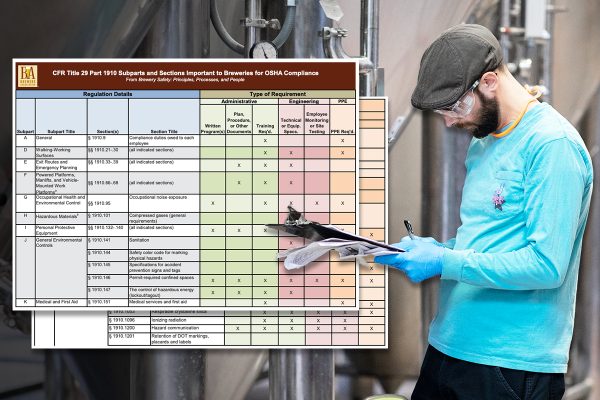I often see employees at breweries wearing dust masks and half mask elastomeric respirators when milling grain or dealing with DE. Should workers be required to wear these masks or are these worn more on a voluntary basis?
If I’m understanding correctly once these air-purifying respirators are required then a written respiratory protection program is also required and this includes mandatory medical evaluations. But, if they are worn on a voluntary basis then medical evaluations are not required.
I’m wondering if there is any information about the amount of grain dust and DE that workers at a microbrewery would likely be exposed to and whether this exceeds the occupational exposure levels. From what I can find OSHA cites occupational exposure levels for grain dust and DE at 10 mg/m3 and 80 mg/m3 by %SiO2 respectively.
The Safety Exchange Says: You’ve brought up two great points: When is respiratory protection required? And, how do we make sense of the occupational exposure limits?
A voluntary use program without fit testing and medical screening is permitted by OSHA for filtering facepiece (disposable) respirators. For these respirators it is still a good idea to ensure that the employee does not have a medical condition that could be aggravated by use of a respirator and the employee needs to be provided with training on the contents of Appendix D of the respirator standard. Appendix D covers the proper use and limitations of a filtering facepiece respirator.
When a 1/2 face-piece elastomeric respirator with cartridges is used then there has to be a written respirator program, medical screening, maintenance and cleaning procedures (for example filter cartridge change schedules), and employee training. OSHA has a very good respiratory protection guidance available here.
Grain dust has been known for centuries to cause chronic respiratory conditions of bronchitis, occupational asthma, and allergic sensitization. Acute effects include wheezing, tightness of the chest, and coughing similar to symptoms of cigarette smoking. OSHA has established a Permissible Exposure Limit (PEL) of 10 mg/m3 for grain dust. This standard is not current with recent research on the health effects of exposure to grain dust, but it is the legal standard for American employers. The American Conference of Governmental Industrial Hygienists (ACGIH), which develops consensus standards based on more recent research, has established a more protective threshold limit value (TLV) of 4 mg/m3.
With diatomaceous earth (DE) you have a similar situation in which the PEL is 50 mg/m3 divided by the percentage of DE that comprises crystalline silica. DE is principally composed of the less harmful amorphous silica. Meanwhile, the ACGIH recommends a flat 10 mg/m3 for DE. From a health standpoint, DE products with the lowest concentrations of crystalline, fumed, or fused silica are best. OSHA’s final rule on respirable crystalline silica can be found here.
The only way to be sure what type of respirator is needed when working around grain dust or DE is to complete air sampling on employees performing typical tasks in the brewery to determine the level of exposure. Sometimes your workers’ compensation insurance carrier may perform this work for free if asked, or you can consult with a Certified Industrial Hygienist (CIH) for a fee.
Remember, respirators, like all personal protective equipment are considered a last line of defense. If employee exposures exceed recommended limits additional local exhaust ventilation or work practice changes can be more effective in reducing exposure levels.






